Shevlin Sebastian's Blog, page 33
December 2, 2019
Hitting the 2000 mark

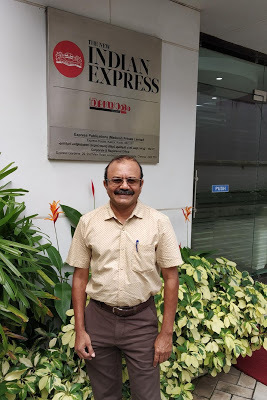
Dear Friends,
Just to say that I have reached a personal milestone.
Published my 2000th bylined feature article in The New Indian Express.
My career total is about 4500 bylines.
A very grateful thanks:
To the management
Group Editor GS Vasu
Sunday Magazine Consulting Editor Ravi Shankar
Resident Editor Kiran Prakash
And to my colleagues across all editions in Kerala, South India and Delhi
Also:
To my former bosses and colleagues.
To my family for their love and support.
Thank you very much
Published on December 02, 2019 23:01
December 1, 2019
A steely resolve
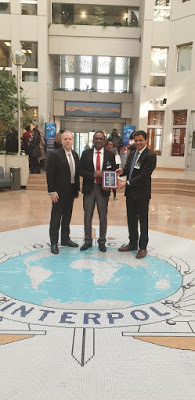
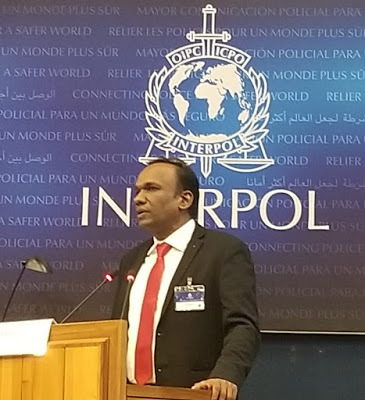
Police chief Manoj Abraham received an award on behalf of Kerala Police at an Interpol conference in France for the work done by them to fight the menace of child pornography By Shevlin Sebastian
Manoj Abraham, Additional Director-General of Police was feeling upbeat. He has just returned after participating in the 37th Interpol specialist group on crime against children in Lyon, France. More than 250 experts from 70 countries took part. In his speech, he explained that the Kerala Police Cyberdome had a campaign called Operation P-Hunt to ferret out paedophiles, administrators of porn groups and makers of films. In the past eight months, the police were able to register 38 cases and arrest 650 men through the Protection of Children from Sexual Offences and IT Acts. Manoj got sustained applause. “These figures were unimaginable for them,” he says.
And the organisers were so happy they gave a prize to recognise the superlative efforts of the Kerala Police. It was presented by the International Centre for Missing and Exploited Children. On the plaque it was printed: In recognition of your outstanding leadership in protecting children all over the world’.
It had been an enlightening four days for the police officer. “I also experienced a wrenching feeling after listening to the speeches,” says Manoj, who is a father of three young boys. “There were cases where paedophiles were waiting for a child to be born. They want to do sex with infants and children till the age of 15. It is a sickness. There were cases where fathers had raped their daughters. Grandfathers had raped granddaughters. One man raped his daughter as well as his granddaughter.”
What impressed Manoj at the conference was the resolve shown by the West. “They said we will fight till a child can live as a child,” says Manoj. “It is their determination that impressed me. The governments, as well as private companies, are spending millions of dollars on developing software to identify these people. And when they saw our efforts they said they would give the software to us for free.”
Because of their stringent attitude as well as tough laws, many Western paedophiles travel to the East and other developing countries to get sex. In a place like the Philippines, in exchange for money, they can do the deed without any fear of the police or local society, who turn a blind eye to what is happening. “They also go to tourist places where they can hide in the presence of many visitors,” says Manoj. “So Kerala is an attractive destination for them. Which is why we are on high alert all the time.”
Meanwhile, the demand for online child sex videos is insatiable. The police chief says it is mostly done using the mobile phone. “And it is usually somebody close to the child -- parents, siblings or relatives,” says Manoj. “Around 70 per cent is within the household. And the rest are from the immediate vicinity. Very rarely are children kidnapped for filming. It would be as low as 5 percent.”
What was an eye-opener for Manoj was to realise that what he experienced in Kerala was what law enforcement faced everywhere. “So, even in the West there are instances of fathers raping their daughters and this is also happening here,” he says. “Education or no education, rich or poor, sexual crimes against children are happening everywhere. And so, there has to be a global effort to finish off this menace.”
Boxes: Transmission of Child Sexual Abuse Materials Dark Net Social Media -- Telegram, Whatsapp, Omegle and Chatzy (anonymous chats)File Hosting Services - Drop Box, Google Drive
Cyberdom Police FindingsIn Kerala, child pornographic content is shared through a Telegram Channel named ButterflyThe administrator is called ‘MLPM’. He was managing 35 porn groups. The total number of members was 38000.
Police Cyberdom PartnershipsFive Academic InstitutionsSix Government agencies 12 NGOsStudentsBanks Kerala State Mission 800 ethical hackers250 mobile technicians
(The New Indian Express, Kerala editions)
Published on December 01, 2019 21:27
November 29, 2019
Tokyo, here we come!
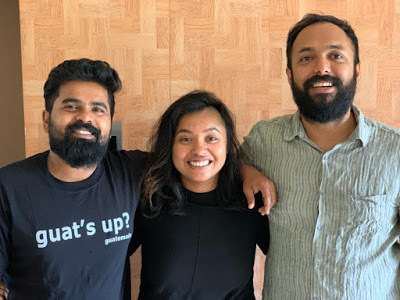
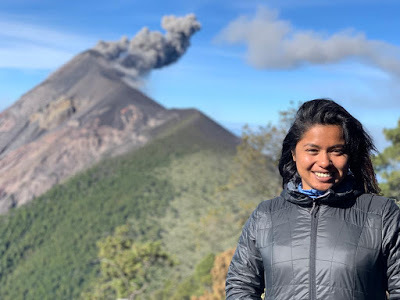
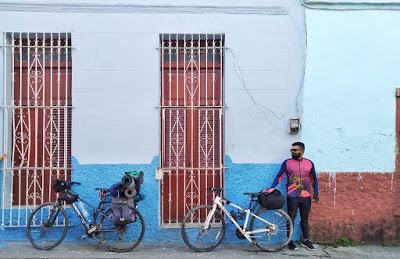
Three people -- Clifin Francis, Dona Jacob and Haseeb Ahsan -- will set out on an eight-month journey on cycles from Kochi, across eight countries, to reach Japan in time for the Olympics
Photos: (From left): Clifin Francis, Dona Jacob and Haseeb Ahsan; Dona Jacob; Clifin Francis
By Shevlin Sebastian
On most mornings, at 9 a.m. when Haseeb Ahsan stepped out of his house in Indira Nagar in Bengaluru, he pulls out a Bergamont Endurance 6 cycle. He used to travel by the metro. Now it is a cycle. He is on his way to the Amazon office at Yeshwantpur, a distance of 15 km. One day a neighbour asked him the reason why he had begun cycling to work.
“I am in training,” said Haseeb. “I will be going on an eight-country, 10,000 km journey spread over eight months, along with two friends of mine. We aim to reach the Olympics Village in Tokyo.” The Olympics is from July 24 to August 9.
Apart from cycling, Haseeb gets up at dawn and goes for a long-distance run. And in the evening it is gym work. His colleagues are also in training. They include the Kochi-based Clifin Francis and the Mumbai-based Dona Jacob. While Clifin is a teacher, Dona is in the IT industry.
Both have done long-distance cycle rides earlier. Last year, Clifin rode from Dubai to Moscow to attend the football World Cup. That was where he met Haseeb who had come to watch the tournament from Bengaluru. In 2015, Clifin hitchhiked across Myanmar, Thailand, Cambodia, Laos and Vietnam. As for Dona, she had been stationed as Technical Head of a leading Indian software company in Mexico. As a result, she was able to cycle around Cuba, which was a 1000 km journey. She also backpacked across Mexico and Guatemala.
For Haseeb, this is his maiden adventure. “In life, there is always a first time,” he says, with a smile. “I am going on this journey because I want to take a break. I want to know whether I want to do something else, maybe a change in career. I have an MBA but I like writing. I want to ask myself what are my priorities. In short, I want to clear my head.”
Clifin and Dona plan to start from Kochi on December 15, while Haseeb will join them a month later. They are starting from Kochi and will go to Bengaluru, Vishakapatnam, Bhubaneshwar, Kolkata, Mizoram, Meghalaya, on to Bangladesh, Myanmar, Thailand, Laos, Vietnam, China and then on to Japan.
“Every day we are planning to ride 100 km,” says Clifin. “Three hours in the morning and two hours in the evening. After a day of cycling, we will take a day off and see the tourist sights.”
On the journey, they will gather wishes for the Indian Olympics team. “For that, we will be carrying an Olympic poster which will be signed by people through all the countries we are going through,” says Dona. “When we reach Tokyo we would like to hand it over to the Indian team.”
The trio will be holding a photo exhibition in Tokyo with pictures and videos from their trip. And there will be daily updates on their Instagram page, ‘Snails.On.Wheels’. They will also work with NGOs to give talks on mental health, the importance of gender equality, women’s empowerment, and the importance of girls’ education in rural India. Other subjects include breast cancer and the need for regular check-ups.
As for the type of weather they will face, Haseeb says, “We are travelling through Asian countries. So, it will mostly be sunny, humid and rainy. Japan is expected to have a hot summer.”
As for the underlying message to the public says, Haseeb says, “I was an athlete as well as the captain of my college football team in Kochi. I gave up everything in the past few years. That is something which happens to us Indians. We stop physical activities altogether. I want to tell people that they should restart exercises as it is closely connected to our mental make-up. It relaxes and calms the mind. We perform much better, as a result.”
(The New Indian Express, Kochi)
Published on November 29, 2019 23:48
November 27, 2019
The Lone Ranger
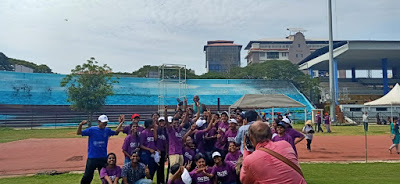
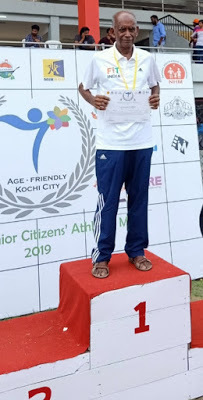
90-year-old PS John was the only athlete in his age group at All Kerala Senior Athletics Meet in Kochi
By Shevlin Sebastian
The sun was shining brightly at noon on Saturday morning. The sky was blue with wisps of white clouds floating by. On the synthetic track of the Maharaja’s College, Kochi, the 100m event of the All Kerala Senior Athletics Meet was taking place. But what was unusual was that there was only one competitor. His name is PS John. And he was taking part in the 90 plus age category. Not surprisingly, there was nobody else running at that age.
To the cheers of the sparse crowd watching the race, John breasted the tape easily. A group of volunteers from the Sacred Heart College at Thevara got so excited by this feat that they lifted John on to the shoulders of a couple of the students, and the whole group yelled and shouted. “I had a great time,” says John.
In the afternoon, he won the 200m gold as well as the long jump. “I was a bit tired during the 200m, as it was hot and humid,” says John.
John’s athletic career had ground to a halt when he had heart surgery in 2017. But his love for running remained undiminished. Thanks to the encouragement of his cardiac surgeon, Dr Rajesh Raman Kutty, John started training again.
Last year, for the same meet at Maharaja’s college, he told his family he had been chosen to distribute prizes. But instead, he took part in the 100m and won. He called his daughter from the stadium and told the news. “I remember shivering with fear,” says Sindhu. “But my anxieties have proved unfounded. Dad has got better and better.”
Says Dr Raman Kutty, “It is a feat of confidence, determination, perseverance and hard work.”
In love with athletics
Asked how he got interested in athletics, John says that it was his joining the National Cadet Corps (first batch of the Travancore Battalion) in 1948 that made all the difference. At Thiruvananthapuram, he saw a group of Army men doing the hurdles. “I was immediately attracted to the sport,” says John. “Slowly, I began training with them. They taught me the right techniques. I began to practise regularly. Soon, I began winning medals.”
He has won, state, national and international medals -- more than 140 gold, silver and bronze medals.
In his daily life, John is a farmer at Kanjirapally. He grows rubber, cocoa, bananas, jackfruit and organic vegetables. “I get pure milk straight from the cow,” says John. “There is a peaceful feeling when you work in Nature. Walking around enables me to keep fit. My aim is not to be bedridden for a single day.”
Before farming, John had a 33-year-long career as a teacher of Malayalam at the Gracey Memorial High School in Parathode, Kottayam. “I studied Sanskrit, but ended up teaching Malayalam,” says this father of two. While son Roy, an electronics engineer, runs his own business in Kochi, daughter Sindhu is a French teacher at Salem.
When asked about his future plans, John says, “I want to take part in the senior world athletics championships in Toronto in 2020 in the 90 plus category. If God allows it, my dream will come true.”
(The New Indian Express, Kochi)
Published on November 27, 2019 01:30
November 26, 2019
A smooth separation
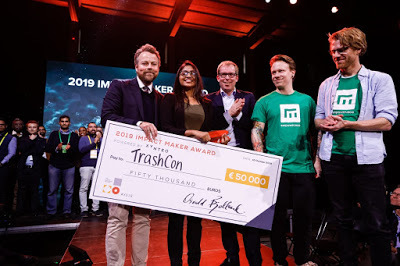
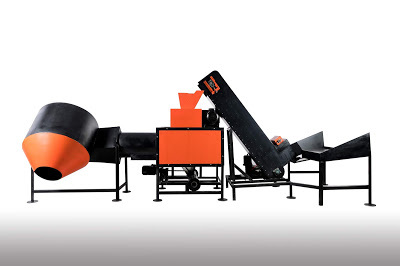
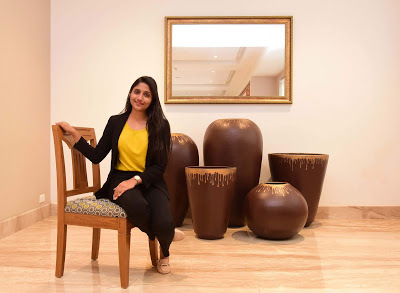
Nivedha RM, who founded the Trashbot, a machine that separates bio-degradable and non-biodegradable waste without the need for segregation, has won the 2019 Impact Maker Award
Photos: Nivedha with the cheque; the Trashbot machine; At Kochi. Photo by Albin Mathew
By Shevlin Sebastian
On October 10, in Oslo, the Norwegian Minister of Trade and Industry, Torbjørn Røe Isaksen took to the stage. He was given a red envelope. The announcer said, “In this envelope, there is the name of somebody who will win a cash award of 50,000 euros (Rs 40 lakh).”
On another stage, stood the 35 short-listed participants of the 2019 Impact Maker Awards. This is a global competition for entrepreneurs who can provide unconventional solutions to some of the world’s toughest problems. Isaksen said, “The winner is..” He paused, opened the envelope and shouted, “Trashcon!” There were whoops of delight among a few members of the audience as Nivedha RM, the founder of the Bengaluru-based Trashcon, wearing a black business suit, stepped forward and accepted a large cardboard cheque.
When asked how she was feeling, Nivedha said, “It’s a dream come true.”
Nivedha had invented the TrashBot, arguably, the world’s first machine that automatically separates bio-degradable and non-bio-degradable waste, without the need for segregation at the house, office or factory.
At the Municipal Corporation ward at Basavangudi in Bengaluru, the Trashbot machine has been placed at one side. It is made of black and red panels. A worker dumps a load of garbage at the entry area of the machine. It contains beans, potatoes, rice, shampoo bottles, a shaving brush, diapers, and yellow plastic packets. Soon, a man, wearing gloves, presses two red buttons at the same time.
The waste moves forward and enters a magnetic shoot first. This will remove the screws and nuts. Then it goes into a second level where the batteries are removed. An arm pushes all the metals to one side. The rest of the waste moves to a loading conveyor. The food packets are cut into several slits.
“By this method, we can dislodge the bio-degradable waste that was sticking to the packet,” says Nivedha. Then it hits a blast of air. The biodegradable waste falls, even as the plastic and other materials are carried into another chamber. “That’s how the segregation takes place between non-biodegradable and bio-degradable waste,” says Nivedha.
A worker collects the bio-degradable waste and puts it into another machine, placed nearby, where it is converted to compost, biogas or biofuel. And, thanks to a new technology invented by Nivedha and her team, the non-biodegradable waste is being converted into boards. “It looks like plywood but these are very strong,” says Nivedha. “The boards are very compact. It is water-resistant, as well as termite and rot-resistant. And it is one-fifth the price of plywood.”
Nivedha pauses and then says, “This could become a very successful business. Many companies have shown interest.”
At Kochi, to give a talk, Nivedha breaks out into a broad smile. So consumed is she by this passion to do something about the waste that she speaks non-stop, lunch forgotten, a woman on a mission.
And this mission began accidentally. A couple of years ago, when Nivedha would go to attend classes at the Rashtreeya Vidyalaya College of Engineering, she would notice that the streets were strewn with garbage. “I thought that instead of doing rallies or campaigns, I would clear the one-and-a-half km long stretch,” she says. So, on January 26, 2016, a group, using gloves and led by Nivedha, physically cleaned it.
However, within a week, the waste accumulated once again. When she spoke to the chief engineer of the Bangalore corporation, he said that unless the waste is segregated, there is no chance of recycling. He said there are no more landfills in Bengaluru. “So, indirectly he was telling me the waste would remain on the streets,” says Nivedha.
So, she decided to make a machine which would automatically segregate the waste. Her mother encouraged her by putting in Rs 2 lakhs. As she started work, she also applied for a grant to Elevate 100, an initiative of the Karnataka State Department of Information Technology and Biotechnology to provide a comprehensive entrepreneurship platform for startups. Out of 3000 applications, 100 were chosen. And Nivedha got selected and got a grant of Rs 10 lakhs.
Through numerous trial and error methods, over two years, and with the help of a friend Saurabh Jain, a chemical engineer as well as a chartered accountant, who later joined her company, as Co-Founder, the TrashBot was made. Now Nivedha wants to spread the word so that many more municipal corporations can use it and avoid the necessity of piling up garbage in landfills. “By using Trashbot, one day, there will be no waste at all,” says the 24-year-old.
Published on November 26, 2019 01:15
November 25, 2019
All for the tiger
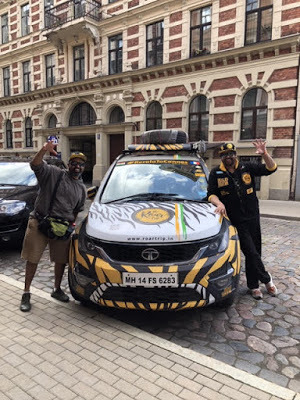
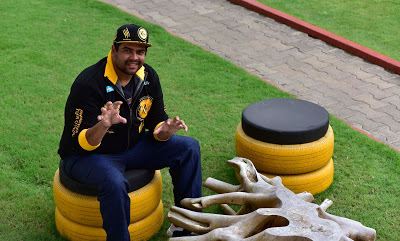
After a 27,500 km trip through 25 countries, championing the cause of the animal, entrepreneur Gautom Menon talks about his experiences, while on a recent visit to Kochi
Pics: Paul George Vedanayagam (left) and Gautom Menon beside their vehicle; Gautom Menon. Photo by Albin Mathew
By Shevlin Sebastian
On a highway in Kyrgyzstan, entrepreneur Gautom Menon was cruising along, with his friend Paul George Vedanayagam. Music was being played over the speaker system. The air-conditioner purred silently. It was an Indian Tata Hexa. They were feeling good.However, in the distance, a sight made Gautom frown a bit. A policeman in a navy blue uniform with a large blue cap was waving them down. He slowed down.
Through Google Translate, the policeman said, “You are over-speeding -- 100 km per hour.”
Gautom said, “We never do more than 90 km/hour.”
“The speed limit is 80 km/hr,” said the policeman.
Gautom said, “Where is the evidence?”
The policeman smiled, looked at the sponsor logos on the car, took out a small tin box, with a slit and said, “You have a lot of resources to do such a long journey. So give us something.”
Gautom then took out a cash donation box and said, “We are also asking for donations.”
Then he told the policeman that the duo was on a 27,500 km journey, from India, across 25 countries to create awareness of the plight of tigers. Gautom is the founder and chief brand owner of the Wild Tiger Indian rum. And he also has a White Tiger Foundation called WTF with the tagline ‘Roar for our tigers’.
The policeman was still not convinced. Then Gautom hit the punchline: “We are in contact with your Ministry of Tourism. We will be in your main news tonight.”
Reluctantly, the policeman allowed them to go.
The duo set out on July 4 from the Parambikulam Tiger Reserve. From there, they went to Coimbatore, Bangalore, Hyderabad, Nagpur, Pance, Cuttack, Bhubaneshwar, Kolkata, Siliguri, Darjeeling, Guwahati, Shillong, Imphal and Myanmar.
“From Myanmar, we went to Thailand, Laos, China, Kyrgyzstan, Kazakhstan, Russia, Estonia, Poland, Hungary, Croatia, Slovenia, Slovakia, Czech Republic, Austria, Germany, Netherlands, Belgium, Luxembourg, France, Switzerland, Italy and France,” says Gautom.Along the way, they held meetings, did Powerpoint presentations, and media interviews to highlight the fact that there are only 4000 tigers worldwide.
“Out of this, 70 percent can be found in India,” says Gautom. “Which is why India is the land of the tiger. We need to act now. I always say, ‘Take a moment and look at the person on the left and right. We are the generation that is going to see the tiger being wiped out. So we should act now.’ Do remember the one-horned rhino has become extinct because of our apathy. So, we must make a difference.”
Everywhere they went the duo got a good reception. Except in China, where they eat tigers. “In China, they said just said, ‘Nice car. Can I take a selfie?’” says Gautom. “They showed no interest in the fate of the tiger.”
Incidentally, out of 50 tiger reserves in India, three have no tigers left, and they are all in the North-East. “They have been wiped out there, owing to the demand in China,” says Gautom.
The duo reached Cannes on October 4 in time for the annual convention of the Tax Free World Association. Around 35,000 people, including many CEOs, were present from all over the world. “We wanted to make it a big cause,” says Gautom. “And we wanted people to talk about it.”
And people did. Unfortunately, corporates in India are not talking about it. “Indian corporates always think of building a legacy by naming a school, hospital, or a sporting facility in their name,” says Gautom. “Very few of them think of adopting a tiger or doing something for the environment. But what we are trying to do is to ask firms who use animal images as their company’s logo to do something.”
Esso Corporation, which was the world’s largest company until a few years ago, has a tiger mascot. “After much pressure by [Padma Shree awardee] Dr K. Ullas Karanth, the No 1 tiger expert arguably in the world, they finally gave a paltry $10,000. It is a $45 billion company and their tagline is ‘put a tiger in the tank’. There is an urgent need for a mindset change.”
Gautom gives another example. “There is a billion-dollar company in Denmark called Flying Tiger,” he says. “Lennart Lajboschitz, one of the richest people in Denmark owns it. But the company wants to do something for education. That is important. But the link between the name of the company and the animal is not there.”
But there are exceptions. The owner of the Mumbai-headquartered DSP Black Rock Hemendra Kothari gives Rs 5-10 crore to his company’s Wildlife Conservation Trust. “He has single-handedly done so much for the wild cats,” says Gautom.
Meanwhile, Gautom, while on a recent visit to Kochi, was still assimilating his experiences. “I had such a wide variety of food, encountered so many different cultures, especially in the North-East and seen all types of weather -- desert storms, hail storms, landslides and floods. And everywhere I noticed that once people realised we were genuine travellers, they were willing to help us. We never felt threatened. The vast majority of people are good-hearted.”
(The New Indian Express, Kochi and Thiruvananthapuram)
Published on November 25, 2019 01:09
November 18, 2019
Animal instincts
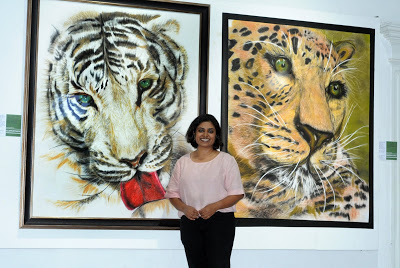
Artist Diana Joseph’s exhibition focuses on the character traits of tigers, lions, zebras, stags, deer, wolves and elephants
By Shevlin Sebastian
At the David Hall art gallery, artist Diana Joseph shows her hands. It’s small and compact and looks fine. But Diana is suffering from Carpal Tunnel Syndrome. That means it is difficult for her to hold a pen or a brush. “It is an irreversible degeneration of the nerves,” she says. “This happens when you use a computer too often. Many in the IT industry suffers from it.”
As a result, Diana uses her fingers to paint. She mixes colours directly on the painting, or sometimes she uses reverse painting. In this method, to remove bits of the paint, she uses a razor or knife if it is acrylic. When it is oil it is turpentine and cloth. She says she uses three mediums interchangeably in a single canvas -- acrylic, pastel and aqua oil.
The works are large -- 5’ x 4’ or 5’ or 6’. The exhibition, titled, ‘Manimal’ features tigers, lions, zebras, stags, deer, wolves and one elephant. This elephant has two gleaming ivory tusks, flapping ears and a piercing eye.
Diana has been a fan of elephants since her childhood. She would come from Bangalore, for her summer vacations to her grandparents’ home, beside the Koodalmanikyam Temple, in Chellur, Irinjalakuda. “In May, it would be the pooram season, and the elephants would stay in our courtyard,” says Diana. “I would spend an entire day just watching the movements of the animal. It was fascinating. Maybe, I was meant to love elephants. My name Diana has an ‘ana’ (elephant) in it.”
In almost all the paintings, the eyes are the most powerful feature. So, a tiger has a luminous green pair of eyes. “In real life, their eyes glow in the dark,” she says. “It takes me a bit of time to fix the eye. It is the most challenging to create. Like in humans, the eyes are like a window to the soul of the painting.”In a work called ‘Linger’, two lions are cuddling each other. Their eyes are warm. Diana seems to say that even in the toughest of animals, they have tender moments.
In another image, two wolves hold their faces next to each other. Unusually, for the animal world, wolves have a monogamous attitude. And when a wolf loses his partner he will never go in search of another mate. “This is a singular trait in wolves,” she says. “That’s why their numbers have dwindled.”
Another image is of a gorilla, semi-angry, who has striking red eyes. All animals have coloured sclera (the white outer layer of the eyeball). A crocodile has yellow scleras, a turtle green, while a wolf has blue eyes. Only man has a white sclera. “Because of this white background, one can easily gauge the emotions of a man,” she says. “But you can’t do that with animals. You cannot know what they are thinking because of their coloured scleras.”
Then there is the image of a stag and doe with their antlers entwined. But in a gap between the two antlers, Diana has drawn a setting sun. “Sunset is a very important moment for animals,” she says. “This is the time when they communicate with each other. Sunset is the time when they realise that the day is coming to an end. It is time to settle down for the night. Actually, we can learn a lot from the animal world.”
Says visitor Shelton Pinheiro, a creative director of an advertising agency, “Diana’s paintings draw us into a dizzying whirlpool of detail. Every hair, highlight and texture stand out in stark relief. Most of the canvases loom large over the viewer.”
In her daily life, Diana runs the Kochi-based NGO ‘Venda’ (Say No To Drugs). “Every day, there is a crisis,” she says. “So, painting is a refuge for me.” She re-started her hobby two years ago, after a 20-year-hiatus. From childhood, Diana had loved painting. But for various reasons, she was not able to continue. But when she began, Diana made a quick impact. A few collectors in Germany own her works as well as the Bangalore-based Ashok Soota, the founder of MindTree. He has a painting of a lion called ‘Caterwaul’.
He told Diana, “You work is mesmerising. I had a party recently and the painting stole the show. The immense detailing is unbelievable.” In the ongoing exhibition, a foreign collector has expressed his interest in owning one. “Yes, there are others too who want to acquire my works,” says Diana. “I am lucky.”
(The New Indian Express, Kochi and Thiruvananthapuram)
Published on November 18, 2019 23:26
November 17, 2019
Truly alone but standing strong
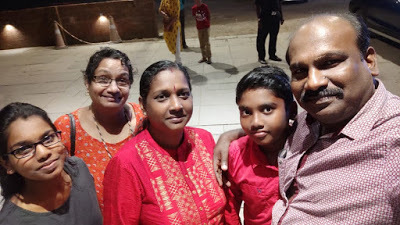
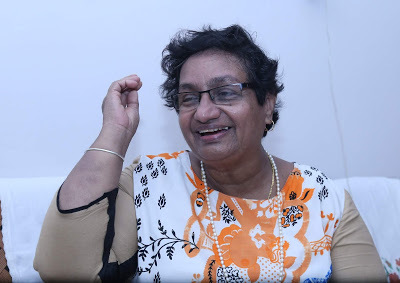
As Sr. Jesme turns 63, she recollects the joys and tribulations of her life
Pics: Sr. Jesme (second from left) with the family of Rajesh Raj PR; Sr. Jesme
By Shevlin Sebastian
On November 1, when Sr. Jesme went to the Treasury office at Thrissur, to find out about her pension, the Sub Treasury Officer Rajesh Raj PR said, “Sister, I can see that your birthday is on November 6. So, can I get a treat?”
Rajesh had always been helpful to Sr. Jesme. So, Sr. Jesme said, “Sure, but you must bring your family along.” Rajesh nodded.
So, on the night of November 6, Rajesh came in his car to collect Sr. Jesme at her home. He was accompanied by his wife, Ayurveda doctor Preethy, daughter Jyotilakshmy and son Jyotis. The group went to one of the newer restaurants called Round -- The Global Diner and had an enjoyable meal. Otherwise, on that day, no one dropped it to see the former nun. And she did not cut any cake.
Sr, Jesme, who has turned 63, lives in an 1100 sq ft flat on the third floor of an apartment complex. She has a living-cum-dining room, a kitchen, two bedrooms with attached bathrooms along with two verandahs. “But for this privilege, I am paying a steep EMI,” she says with a smile. “However, I am grateful for my pension from the UGC (University Grants Commission)” [Sr Jesme had been principal of St. Mary’s College, Thrissur, from 2005-8].
It’s been 11 years since Sr. Jesme left the Congregation of the Carmelities of Mary Carmelite for reasons of emotional torment. Asked about her feelings, she says, “I feel relieved and happy. I am leading my own life. Freedom is a pivot of my life. For example, I can get up whenever I want. And go wherever I want. I can read whatever and whenever I want. In the convent, our freedom was curtailed. There was a constant infringement of human rights.”
This also happens to ordinary women in our society. “The majority of women don’t know what it is like to be a human being, to have the freedom to make their own decisions,” she says.
Nevertheless, it is not all hunky-dory for Sr. Jesme. “In our society, a single woman is always singled out and attacked,” she says. “If a woman is ill-treated, she can complain to her husband or a brother or a male relative. People assume that I have no one to defend me. And they are right. I have to fight my battles all alone. I get phone calls where men speak of what they want to do with me sexually. I have been fighting back all these years but at the same time, I try to ensure that I also enjoy life. I don’t want to lapse into bitterness and anger.”
What has been heartening for her is that the attitude of the Catholic laity has changed a lot. “I have a neighbour who is a Catholic,” says Sr. Jesme. “They are very loving towards me. I go and spend time with them. I am so happy that I am no longer ostracised.”
Interestingly, her former colleagues also welcome her. “When I see them in a public place, many come and hug me,” she says. “They ask me whether I am suffering. I reply that I am not suffering at all. They start sharing their problems. And it is the same issues that I had written about in my autobiography, ‘Amen’ (2009).”
Nothing has changed, she says. “Many are fed up with convent life and want to leave. But none can do so because, firstly, they don’t have the money to survive on their own. Secondly, the fear of their family and society holds them back.”
Asked her opinion of Sr. Lucy Kalappurakkal who was expelled recently from the Franciscan Clarist Congregation for speaking against rape accused Bishop Franco Mulakkal and other misdemeanours, Sr. Jesme says, “I have two ways of looking at her. Because Sr Lucy was part of an institution and had taken a vow of obedience, I cannot defend her because she broke the vow. But the second way to look at her is that Sr Lucy is trying to redefine the definition of obedience in the 21st century. Regarding this aspect, she has done a great thing. I don’t think ‘blind obedience’ works anymore. It should be ‘responsible obedience’.” Finally, when asked whether she is lonely, Sr Jesme says, “I don’t think so. I would define it as solitude and I enjoy it. I am working on my eighth book. I listen to music, watch TV, and check my Whatsapp and Facebook accounts. Many women call and tell me about their problems. I listen and offer advice. I also share my problems with my close friends. I do a little gardening. I have learned to stitch and now I can repair clothes.”
Sr. Jesme pauses and says, “Life is a gift from God. You must learn to relish every moment.”
(The New Indian Express, Kerala editions)
Published on November 17, 2019 22:26
November 14, 2019
An easy way of disposal
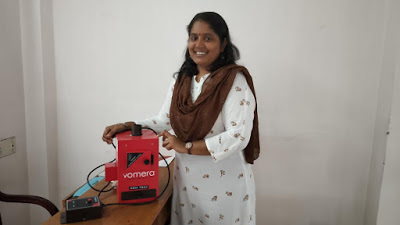
Lijisha CK’s sanitary pad incinerator Vomera has brought a lot of relief to women, both at home and the workplace
By Shevlin Sebastian
Lijisha CK expected a tough sell when she met the elderly president of a private sector bank. She wanted to persuade the senior executive to buy a sanitary pad incinerator called Vomera. This is a product made by her with the help of her husband Krishna Ram. So, her surprise was genuine when the president agreed to buy it almost at once.
And then he explained the reason why. “Just last week, a few girls had come for training in the bank,” he said. “Since they had no place to stay I asked them to stay at my home. Only my wife and I are there. They stayed for two days and left. But after a week, the bathroom pipe became blocked. When the plumber investigated, the cause was the napkins which had been flushed down the toilet by these girls.”
Even in buildings which have large pipes, it gets clogged. Like in the civilians quarters of the Central Reserve Police Force Force at Thiruvananthapuram. “When an investigation was done, the pipes were clogged with baby diapers and sanitary pads,” says Lijisha. “Now they have installed one of our incinerators there.”
Lijisha says that this is also an issue in many multi-storeyed buildings at Kochi. “The problem is that the corporation will not accept these pads,” she says. “Secondly, it is difficult to burn. So installing an incinerator is the best solution.”
It comes in different sizes. For homes, you can buy one for Rs 11,000. 15 napkins can be burnt in a day. “The most popular is one which burns 250 napkins,” says Lijisha. “It is priced at Rs 30,000. And there is a one-year warranty.”
This is how it works. Plug it in. Put the pad through an opening. It falls onto a bed of electric coils. Thus burns up the pad. The ash falls into a tray. There is a bit of smoke which goes out through a pipe which leads outside the window. The ash can be easily thrown away. So far, these have been sold in schools, colleges, hostels, offices and apartment buildings.
The company has had a soft launch some time ago. “It’s just the two of us, and we are expanding very slowly,” says Lijisha. “My husband and I were working for other people. This is the first business we are doing. So we want to move forward cautiously.”
Initially, it was not easy. “When we would say we are doing a sanitary napkin incinerator business, people would say, ‘Could you not have found another business to do?’” says Lijisha. “But now attitudes have changed. People have become more accepting.”
And Lijisha says that she is gratified when she explains the product to small groups of women and sees the relieved looks on their faces. “I am glad to offer a solution,” she says.
One very happy customer is Shaifa A Rawther who works in the HR department of a paint company in Kayamkulam. “There are 10 women in our office,” she says. “Getting rid of sanitary napkins is such a major problem. So we are so happy that there is a product like Vomera. Using it is also very easy. I am so happy about it that I am telling my friends and relatives about it. One day, I even called Lijisha and thanked her for making this product.”
Lijisha also provides a vending machine for napkins. Push a coin into a slot and a sanitary napkin will come out.
(The New Indian Express, Kochi and Thiruvananthapuram)
Published on November 14, 2019 21:49
November 12, 2019
Preserving mural art history
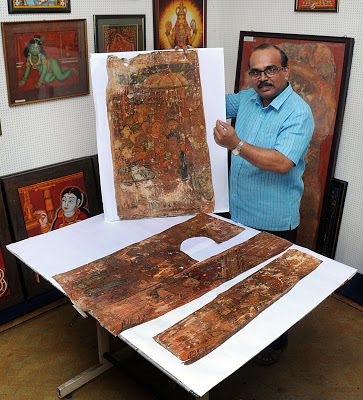
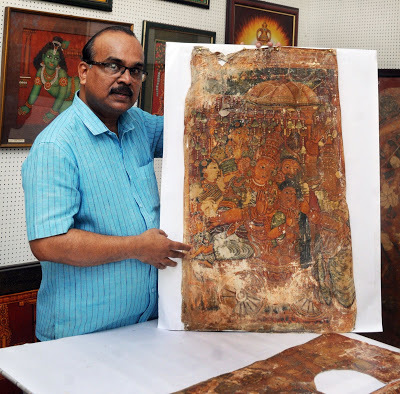
Mural artist Sasi Warrier has extracted several artworks from a wall of the now-demolished Vishnu Narasimha Swami Temple at Elamkulam. He is carrying on the life project of his late father KK Warrier
By Shevlin Sebastian
One day, mural artist Sasi Warrier, who runs the Indian School of Art at Ravipuram, Kochi, got a call. It was from his student, Meera Menon. She said, “Master, they have started demolishing the temple.”
The temple in question is the 800-year-old Vishnu Narasimha Swami Temple at Elamkulam. Sasi immediately got in touch with the temple committee. They had agreed earlier that Sasi could come and peel off the mural paintings. But it seemed they forgot about it, as the roof had just been demolished.
But they made amends by quickly putting up a tarpaulin sheet over the wall on the second floor where the paintings had been etched.
On the morning of October 22, Sasi stood in front of the works, accompanied by his student Shreekumar and Dr CP Unnikrishnan, a well-wisher of the school and Kathakali artist. Inches above them was a blue tarpaulin sheet. On the wall, in front, there was a 3 x 2 feet painting. It depicted a scene from the Mahabaratha.
Krishna’s mother Devaki and Vasudevan had just got married. They are being escorted home by Devaki’s brother Kamsa. A celestial voice tells Kamsa, “This eighth child of this Devaki shall become your death!" Frightened and angry, Kamsa grabs hold of Devaki’s hair to kill her.
Sasi has a time-tested method, as perfected by his artist father KK Warrier, who died on August 6, 2018. He rubbed a chemical on the surface. Then he waited for about two hours. Once the chemical dried up, Sasi took a pocket knife and delicately began to lift the edges. A slight mistake would damage the painting. But his movements were sure-fire and confident. Within a matter of time, the entire painting had been taken off.
He continued to work steadily. Soon, around 12 works of differing sizes had been taken off, without a blemish. They are all now stored at the school. “My next job is to clean the back of the paintings,” says Sasi. “There are bits of mud, the plaster of the wall and dust particles.”
Sometimes, there will be damage at the edges of the work. “The appropriate colour will be added to match the rest of the painting so that people do not know this area has been torn,” says Sasi “After this, it will be framed.”
According to Sasi’s estimate, these works were done in the late 18th and early 19th centuries. “This style can be seen in North Malabar temples, and is similar to the Thanjavur school of painting,” says Sasi. “Unlike most murals, the women are wearing a blouse and saree. This has probably been done by the disciples of a master named Pulakkat Raman, as the style seems to be the same.”
This idea of preservation was KK Warrier’s life project. The first painting the duo saved was one in the Guruvayur Temple in 1986. So far, they have 140 paintings in their possession. And all of them have been registered with the Archaeological Survey of India. Apart from Guruvayur, there are paintings from eight temples across Kerala. These include the Kumaranalloor Devi temple at Kottayam, the Tahikkattusseri Vamanamoorthi temple in Thrissur and the Pallathankulangara Siva Temple at Vypeen, Kochi. The oldest painting -- at the Karivellur Puthoor Siva temple at Kannur -- is 400 years old.
Unfortunately, many works have been destroyed. “Sometimes, it is the handiwork of human beings,” says Sasi. “But there are natural causes, like fire or when rainwater seeps down the surface of the painting. Sometimes, the walls develop a crack. On other occasions, insects and birds, which dwell in the temple premises, make scratches.”
Nevertheless, Sasi has not been deterred. He says that as and when he gets the opportunity, he will continue to save paintings. “And one day, I will be setting up a museum where I will showcase all the works,” he says.
(The New Indian Express, Kerala editions)
Published on November 12, 2019 22:27



